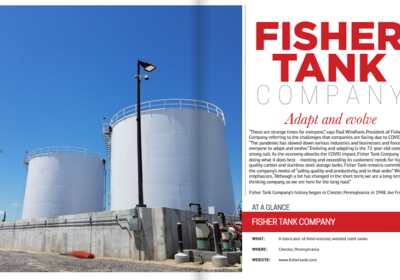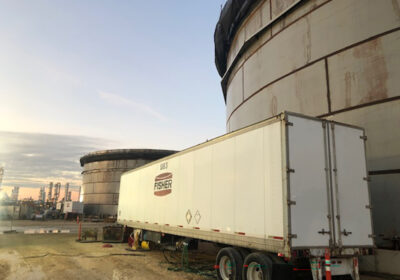WHAT’S THE #1 KNOWN CAUSE OF STORAGE TANK FIRES?
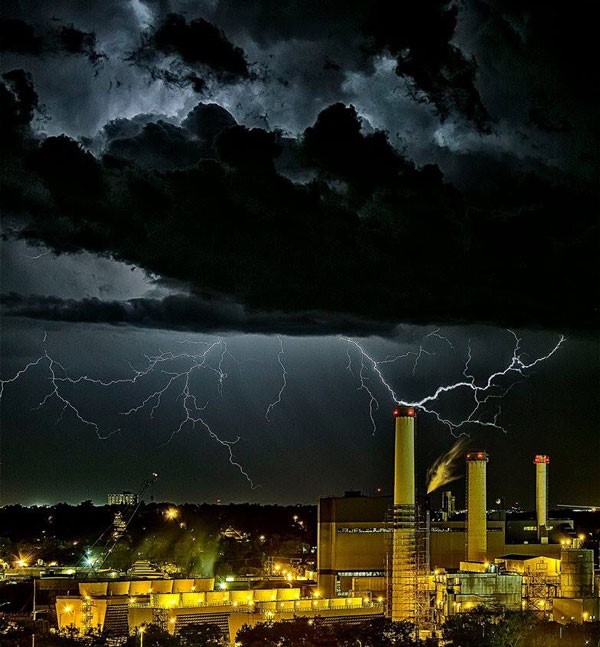
Lightning is the leading known cause of storage tank fires, and it’s a constant threat to people, facilities and product. Today we welcome JoOnna Silberman, aka the LightningDiva@Large, to the Think Tank. JoOnna specializes in lightning protection, and she’s joined us today to share some expert knowledge about the science of lightning and the impact lightning can have on industry.
Drake Power Plant, Colorado Springs, CO USA- Larry Marr
INTRODUCTION TO LIGHTNING BY THE LIGHTNINGDIVA@LARGE
Over the past few months I have been asked to write a blog which covers the basics on lightning and lightning protection. It took me a while, but I do believe that I have been able to come up with a simple way to introduce the audience to the basics and give you all the information that you need to get started on contemplating Mother Nature’s dynamite.
In this blog, I review the basics of lightning, and include links and papers which will assist you in understanding how lightning works, the threat that it represents and the steps you should be implementing in order to preserve your assets, protect your employees and maintain safety and sustainability for your company.
In addition, I will cover the different types of lightning protection available, as well as losses and consequences of not having lightning protection. I will not go through every industry, but just a few as examples (Tank Storage and Power Generation). But it is important to note that there is no industry that has not been impacted severely by a lightning strike and/or the secondary effects of lightning.
Also included will be information on Lightning as a weather event and the future it holds.
• About Lightning: How does lightning work?
• The Cost of a Strike: Review the potential damages, losses and consequences of not having lightning protection
• Collection vs. Prevention: The different types of Lightning Protection
• What do I need to move forward?
LIGHTNING 101: PRINCIPLES OF CLOUD-TO-GROUND LIGHTNING
Lightning is caused by the build-up of static electric¬ity within a thundercloud. Negative charge accu-mulates on the bottom of the cloud and induces an equal positive charge on the surface of the earth. When the potential between the cloud and ground reaches about a billion volts, a downward leader begins to move from the cloud towards the earth. When the downward leader gets to about 200 meters from the earth, upward streamers are launched from the earth towards the downward leader. When the downward leader connects with an upward streamer, then the visible lightning strike is formed and massive current flows between the cloud and earth. A more extensive overview of lightning is offered in our paper “Preventing Direct Lightning Strikes by R. Carpenter, P. Carpenter & D. Sletten – March 2014, or viewing our video “The Lightning Discharge Principle”. The video is a comprehensive educational presentation that gives you in-depth understanding of lightning and how it affects a structure.
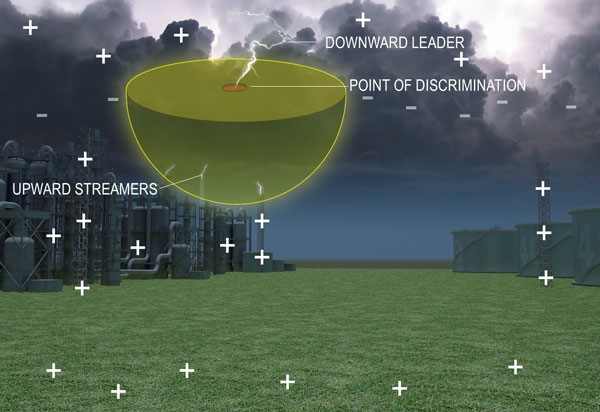
LIGHTNING RISKS
The chance that your facility or structure will be hit varies on a number of factors such as location, structure height and design, temperature, and humidity. If all the factors are just right, even areas with infrequent thunderstorms can experience rare, but high intensity, lightning strikes. One should note that recently it has been reported that lightning is becoming more volatile, striking more frequently both in places that are known for heavy lightning storms but also in regions that have not had many lightning events. I will expand on this topic later in this article.
Lightning can have devastating effects on any oper¬ation, whether taking a direct strike or being sub-jected to the secondary effects from nearby strikes. A single lightning strike to a mission-critical facility poses unacceptable risks which can cripple opera¬tions. These risks can include, but are not limited to, explosion/fire, loss of product, dam¬age to infrastructure, communications, failure of sensitive electronics and equipment, lengthily downtime and more importantly, loss of life. I haven’t even mentioned liability and environmental penalties.
LIGHTNING STRIKE CONSEQUENCES
There are several industries that I could use, but the industries with the most shared data on losses are the Petrochemical, namely Tank Storage and the Energy Industries. But don’t let that fool you. All industries are subject. Most just don’t like to report the losses or publicize lightning strikes in association with their businesses.
In petrochemical facilities, lightning can cause explosions and/or ignite fires that consume millions of dollars of product, create prolonged downtime, demands environmental cleanup, incurs regulatory fines, and causes destruction of equipment– requiring excessive repair or replacement, and impacts entire communities. The repercussions can be exorbitant financially for these companies.
In 2014, we saw a rise in fires at the upstream end of the industry, primarily salt water disposal tanks (SWD, at tank batteries associated with fracking across the United States. We have not yet gotten the numbers associated with many of these incidents, but we know that tanks had to be replaced, product was lost and in some cases the companies were fined by the EPA for no less than $30 Thousand. Not to mention downtime and other potential losses. I cover this in more detail in my July 10 blog covering an article that I did for Fuel Marketers News “Spark, Arc and Boom!“
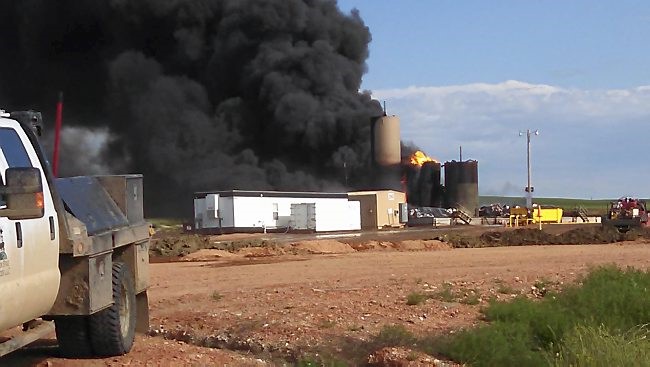
The data we have been able to gather includes incidents from 2013 and before which range in size and scope we have additional data in our “About Lightning & Tank Storage FAQ”, 2014 data is not available yet. There are three good examples below which can give you the idea of the cost of one lightning strike.
• 2013–Louisiana/U.S.A–Denbury Resources, Inc.: Lightning strikes destroying 2 tanks and over 85,000 gallons of crude oil | Estimated loss – $360,000.00
• 2013–Texas/U.S.A.–Ft. Worth Natural Gas, Inc: over 233,000 gallons of crude and combined oil lost and 2 tanks destroyed | Estimated loss – $750,000.00
• 2012–Thailand/Map Ta Phut Industrial Park– Bangkok Synthetics Co (BSC): Lightning Strike at a toluene vessel – 12 dead, 129 injured, environmen¬tal damages, fines and plant closure, manufacturers of 140,000 tonnes/year of butadiene (BD), 55,000 tonnes/year of MTBE, 55,000 tonnes/year of butane LPG, 40,000 tonnes/year of C4 raffinate (isobutylene) and 35,000 tonnes/year of butene-1: Reported Losses exceed $1 Billion
“Did you ever wonder why that five hundred thousand dollar piece of equipment that runs your entire operation, and was budgeted to last ten years, all of the sudden quit working? Well, remember that lightning strike back in June and the other one last year that struck close by?”
In addition, lightning also poses unacceptable risks for electron¬ics and communication systems. Most companies only consider a direct lightning strike as their only risk and don’t consider the secondary effects of lightning. The truth is that a lightning strike can cause damage even when it strikes the ground surrounding a facility. A lightning strike causes an electromagnetic pulse (EMP), which is then coupled to overhead and underground wires and cables, which in turn causes a powerful surge into your equipment and electronics. The effect reduces what is called meantime-between-failure, as covered in my blog from August 28, 2013 “Lightning Strikes are the Weakest Link for Electronics” –this can result in major damage, critical data loss, downed operations and lost business. This risk is shared by utilities, data centers, emergency services, logistics providers, cor¬rections facilities, government and military facilities, process manufacturing, and transport hubs and more. It is often overlooked until it is too late.
We covered basic grounding and surge in our video “The Lightning Discharge Principle” included at the beginning of this article; however, most companies do not consider grounding and/or surge when contemplating lightning. Grounding engineering and surge protection must be incorporated when contemplating the effects of lightning. In two additional videos “Grounding and Achieving an Earth Connection” and ”Smart Ground Testing – Go beyond the normal ground” one can gain a well-rounded understanding of the correlation between the two and lightning, as it pertains to industry and business sustainability. Much of the damage created by a lightning strike is not seen or noticed
In the Power generation and utilities sectors, the effects can be equally troubling. Lightning may strike at any point on the grid, destroying expensive equipment and leaving customers in the dark. In the Lightning Protection Blog from October 9, “Operations Down! Power Off!” I focus on power providers, however, here is a little bit of information that will give you an idea of the potential losses in this sector:
According to the DOE, one report references the following costs to the end-user for momentary outages (costs are per customer) to be as follows:
• Residential – $1.82
• Commercial – $574
• Industrial – $1895
Therefore, for a load serving station that serves 20 MW of load (or 2800 to 4000 residential customers/meters), the cost impact to end-users of losing service is in the range of $5096 to $7280. This is a momentary outage and does not take into account a specialized industrial process that would be impacted, one statement from a high tech manufacturing group mentioned $1,000,000 an outage.
Note: The numbers vary, and are dependent on location. In a highly industrial area and considering the length of the outage the cost can exceed the million dollar mark.
These are just two segments of two separate industries that I have referenced in order to give you an idea of how badly a business can be impacted. Remember, power generation and petrochemical have many more types of facilities and business segments which are also severely impacted when lightning strikes a facility.
LIGHTNING PROTECTION OPTIONS
“Why would you invite the devil into your playground?”
The technology behind lightning rods is over 250 years old. However, in the spirit of education and enlightenment, I am happy to include the three major types of lightning protection used by most industries today. I will tip my hat to Ben Franklin though. You’ve had a great run.
Though lightning rods are the oldest form of lightning protection and still used today, in the past few decades advancements in technology have provided more options. Two major types include the Early Streamer Emitter (ESE), similar in approach to the lightning rod, and the Charge Transfer System (CTS), which takes a completely opposite approach to lightning protection: prevention vs. attraction. A type of CTS, the Dissipation Array ® System (DAS®), works to prevent a lightning strike in a specific area designated for protection.
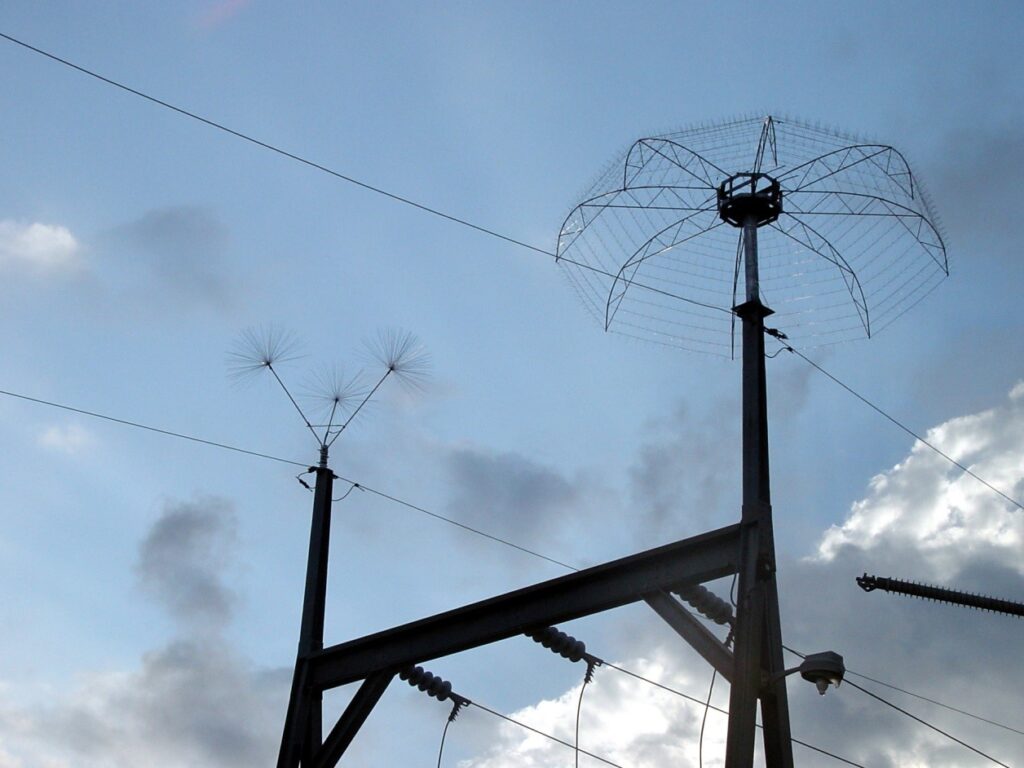
COLLECTION VS. PREVENTION
When it comes to lightning protection, a common misconception is that the different types of solutions available are variations on the same technology. This is not necessarily the case—though the process may rely on the same natural phenomena, the result is entirely different. Although the lightning rod is the most commonly known form of lightning protection, there have been a great number of technological advances since the days of Benjamin Franklin. In addition to the antiquated technology of the lightning rod, two newer technologies are the Charge Transfer System (CTS) and the Early Streamer Emitter (ESE) air terminal. In reality, although both of these products are used for lightning protection, contrary to the public’s understanding, they are very different. An ESE is a similar technology to the lightning rod, while DAS is an entirely different type of technology. The only similarity is that all three initially operate off of the same scientific principal or phenomenon, known as “Point Discharge.” However, their actions diverge; the rod and ESE move toward streamer generation from a single point whereas the CTS utilizes a slow discharge process through thousands of points. Understanding the differences between these technologies is important. For example, it might not be ideal to attract lightning in areas that are highly volatile or indispensable, but instead to prevent it from striking altogether in an area most important to protect. While lightning rods and ESE attract lightning, CTS prevents it from terminating in the area of protection. To read more and also review some of the information already shared about lightning and lightning protection click here.
For a more technical understanding of CTS and DAS, download the entire whitepaper which includes the technical paper “Preventing Lightning Strikes to the Protected Objects” by M. Drabkin, Y. Endo, L.M. Ong, A. C.Y. Mui
THE TAKE AWAY
I believe the most important piece of information that I can share with readers is this. Lightning does not discriminate and it only takes one strike, which can in some cases, destroy an entire company.
- Be proactive, not reactive – Do not wait until you have an incident.
- Investigate your options and ask lots of questions.
- Require that an engineer is involved in your decision making process and in the implementation of the solution.
- Proper analysis must be done in order to provide the best lightning protection possible for each situation.
- No two environments are the same, so the solutions cannot be either.
- A proper lightning protection system requires analysis, design, lightning protection, grounding engineering and surge protection.
- Make sure that the provider you purchase your solution from is a reputable company that has the most experience with the technology.
If you have any lightning stories you would like to share with us, positive or negative and/or if you have any questions or need additional information please feel free to contact me at LightningDiva@lecglobal.com
Be careful out there! Visit www.lightningprotection.com for all your lightning protection needs. Follow us on Twitter, Facebook and LinkedIn for more information and updates as well as some great photos. Thank you for visiting!
The LightningDiva@Large
Click here to read more of our blogs


